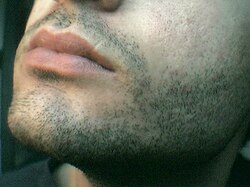چانه
ظاهر
| چانه | |
|---|---|
 دید جلویی گلو (چانه در تصویر دیده میشود ولی برچسبگذاری نشده) | |
| جزئیات | |
| سرخرگها | سرخرگ لثوی پایینی |
| عصبدهی | عصب چانهای |
| شناسهها | |
| لاتین | mentum |
| MeSH | D002680 |
| TA98 | A01.1.00.011 |
| TA2 | 122 |
| FMA | 46495 |
درکالبدشناسیانسانو ادبیات عامیانه، به پایینترین بخشصورت،چانهگفته میشود.[۱][۲][۳][۴]
تورفتگی میان چانه، زَنَخ نام دارد و در ادبیات به چانهزنخداننیز گفته میشود.
چانه دو قسمتآرواره زیرینرا به هم چسبانده و نگه میدارد.[۵][۶][۷]بر روی چانه مردانریشمیروید.[۸][۹][۱۰][۱۱][۱۲]

جستارهای وابسته
[ویرایش]منابع
[ویرایش]- ↑Stringer CB, Hublin JJ, Vandermeersch B (1984).The origin of anatomically modern humans in western Europe. In F. H. Smith & Spencer (Eds.), The origins of modern humans: a world survey of the fossil evidence.New York. pp. 51–135.
- ↑Schwartz JH, Tattersall I (March 2000). "The human chin revisited: what is it and who has it?".Journal of Human Evolution.38(3): 367–409.doi:10.1006/jhev.1999.0339.PMID10683306.S2CID2656256.
- ↑Robinson L (1913). "The story of the chin".Knowledge.36:410–420.
- ↑Coquerelle, Michael; Prados-Frutos, Juan Carlos; Rojo, Rosa; Drake, Abby Grace; Murillo-Gonzalez, Jorge Alfonso; Mitteroecker, Philipp (September 2017). "The Fetal Origin of the Human Chin".Evolutionary Biology(به انگلیسی).44(3): 295–311.doi:10.1007/s11692-017-9408-9.ISSN0071-3260.S2CID38431987.
- ↑Holton NE, Bonner LL, Scott JE, Marshall SD, Franciscus RG, Southard TE (June 2015)."The ontogeny of the chin: an analysis of allometric and biomechanical scaling".Journal of Anatomy.226(6): 549–59.doi:10.1111/joa.12307.PMC4450959.PMID25865897.
- ↑Daegling DJ (1993). "Functional morphology of the human chin".Evolutionary Anthropology: Issues, News, and Reviews.1(5): 170–177.doi:10.1002/evan.1360010506.S2CID85195021.
- ↑Ichim I, Swain M, Kieser JA (July 2006). "Mandibular biomechanics and development of the human chin".Journal of Dental Research(به انگلیسی).85(7): 638–42.doi:10.1177/154405910608500711.PMID16798865.S2CID28529235.
- ↑Gröning F, Liu J, Fagan MJ, O'Higgins P (April 2011)."Why do humans have chins? Testing the mechanical significance of modern human symphyseal morphology with finite element analysis".American Journal of Physical Anthropology.144(4): 593–606.doi:10.1002/ajpa.21447.PMID21404235.
- ↑DuBrul EL, Sicher H (1954).The Adaptive Chin.Springfield, IL: C.C. Thomas.
- ↑Coquerelle M, Bookstein FL, Braga J, Halazonetis DJ, Weber GW (November 2010)."Fetal and infant growth patterns of the mandibular symphysis in modern humans and chimpanzees (Pan troglodytes)".Journal of Anatomy.217(5): 507–20.doi:10.1111/j.1469-7580.2010.01287.x.PMC3035859.PMID20807267.
- ↑چانه در کالبدشناسی انسان (۱۴۰۰-۱۰-۲۰).«ژل چانه».دریافتشده در۲۰۲۴-۰۹-۰۱.
- ↑Bastir M. Frayer D (ed.)."Short faces, big tongues: developmental origin of the human chin".PLOS ONE.8(11): e81287.Bibcode:2013PLoSO...881287C.doi:10.1371/journal.pone.0081287.PMC3829973.PMID24260566.
- مشارکتکنندگان ویکیپدیا. «Chin». دردانشنامهٔ ویکیپدیای انگلیسی، بازبینیشده در ۹ مارس ۲۰۰۸.

